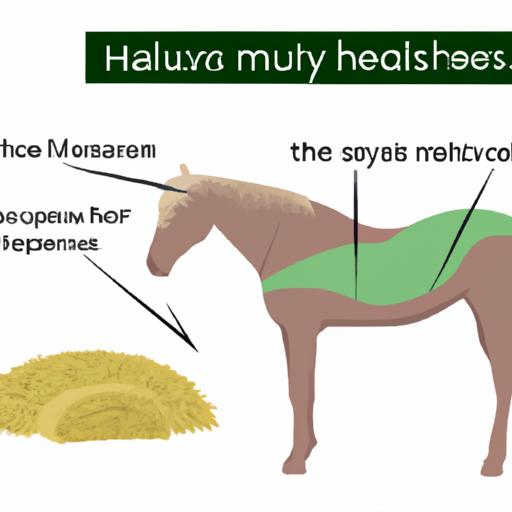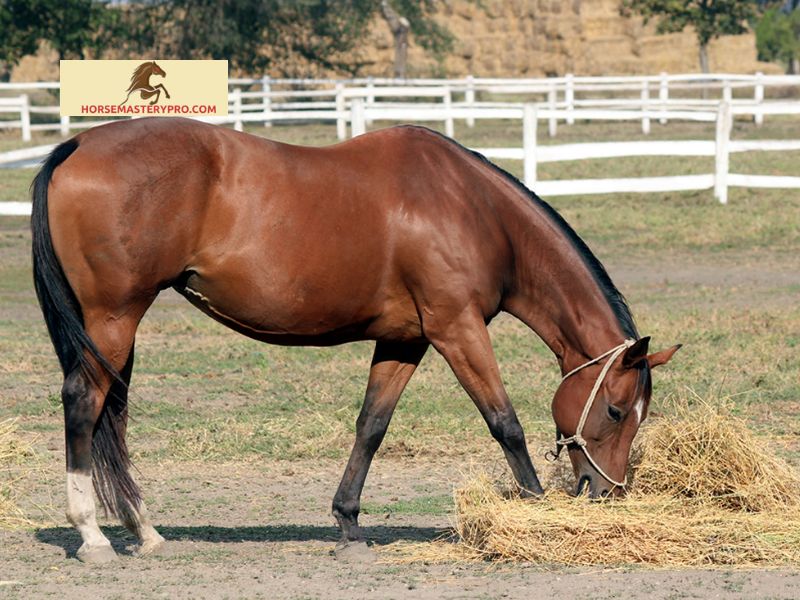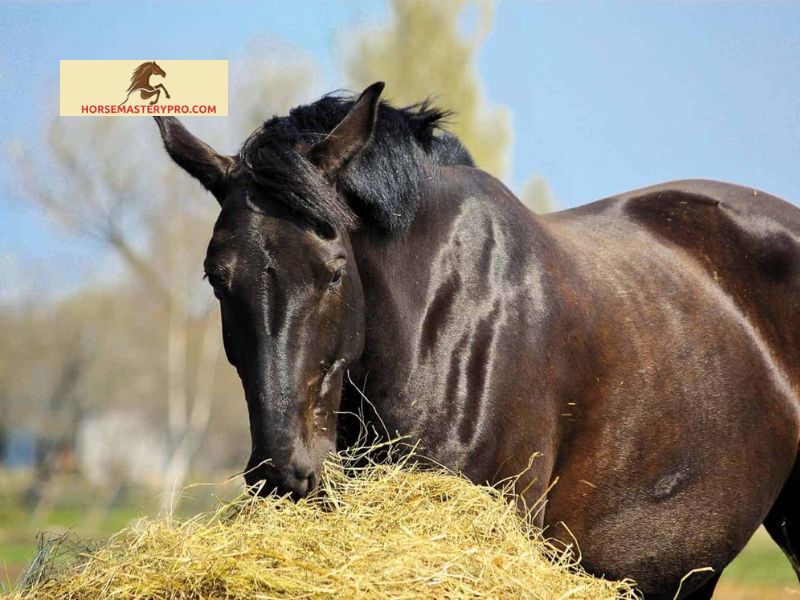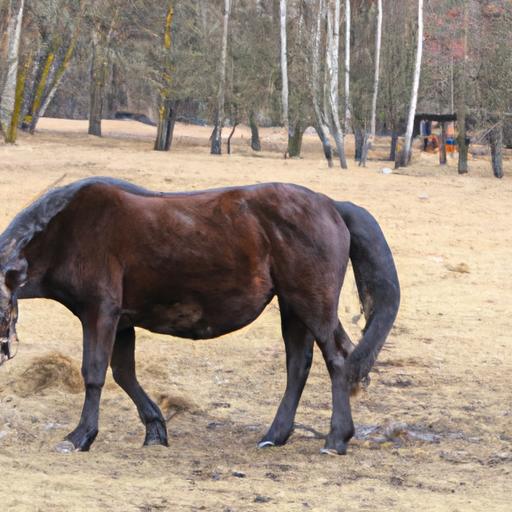Learn how to effectively treat and manage hay belly in horses. Adjust diet, provide quality forage, exercise regularly, address dental issues, and monitor their condition.
As horse owners and enthusiasts, we strive to ensure the optimal health and well-being of our beloved equine companions. However, one common issue that can arise is the presence of a “hay belly” in horses. But what exactly is hay belly? Why is it important to address and understand this condition? In this article, we will delve into the definition, causes, symptoms, diagnosis, treatment, and prevention of hay belly in horses.
Definition and Explanation of Hay Belly in Horses
Hay belly, also known as “potbelly,” refers to a condition where a horse’s abdomen appears distended or swollen, creating a pot-like shape. This condition is often characterized by a disproportionate accumulation of fat or gas in the horse’s belly, resulting in a visibly enlarged abdomen. While it may seem harmless, hay belly can indicate underlying health issues that require attention.
Importance of Addressing and Understanding Hay Belly
Understanding hay belly is crucial for horse owners and caretakers as it can serve as a visible indicator of potential health problems. Identifying and addressing the underlying causes of hay belly can help prevent further complications and improve the overall well-being of the horse. By recognizing the signs and symptoms associated with hay belly, we can take appropriate measures to provide the necessary care and support for our equine companions.
In the following sections, we will explore the various causes of hay belly in horses, the symptoms to watch out for, and the steps involved in diagnosing and treating this condition. Remember, by gaining knowledge and taking action, we can ensure our horses lead healthy and fulfilling lives. Stay tuned to learn more about hay belly and how to effectively manage this condition.
Stay connected to horsemasterypro.com for the upcoming sections, where we will delve into the causes, symptoms, diagnosis, treatment, and prevention of hay belly in horses.
Causes of Hay Belly in Horses

When it comes to hay belly in horses, several factors can contribute to the development of this condition. Understanding these causes is essential in effectively managing and preventing hay belly in our equine companions. Let’s explore some of the primary causes below:
Poor Quality or Excessive Hay Consumption
One potential cause of hay belly is the consumption of poor-quality hay or an excessive amount of hay. Horses require a balanced diet that includes high-quality forage, and a sudden increase in hay intake or feeding low-quality hay can lead to digestive imbalances and an enlarged abdomen.
Lack of Exercise or Physical Activity
Another factor that can contribute to hay belly is a lack of exercise or physical activity. When horses do not engage in regular movement and exercise, their digestive systems may become sluggish, leading to the accumulation of gas and fat in the abdomen.
Inadequate Dental Health or Dental Issues
Dental problems can also be a potential cause of hay belly. Horses with dental issues, such as sharp points or broken teeth, may struggle to effectively chew their food, resulting in improper digestion and an enlarged abdomen.
Digestive Disorders or Imbalances
Digestive disorders or imbalances, such as hindgut acidosis or ulcers, can contribute to the development of hay belly. These conditions disrupt the normal digestive processes, leading to gas accumulation and an enlarged abdomen.
Parasites or Worm Infestations
Lastly, parasites or worm infestations can play a role in the development of hay belly. Internal parasites can cause digestive disturbances and malabsorption, resulting in a potbellied appearance in horses.
By understanding the various causes of hay belly, we can take proactive steps to address and prevent this condition. In the upcoming sections, we will explore the symptoms of hay belly and the importance of proper diagnosis by a veterinarian. Stay tuned to learn more about identifying and managing hay belly in horses.
Saddle up and join us at horsemasterypro.com for the next section, where we will discuss the symptoms and signs of hay belly in horses.
Symptoms and Signs of Hay Belly

When it comes to identifying hay belly in horses, it is essential to be aware of the various symptoms and signs that may indicate its presence. By recognizing these indicators, we can take prompt action and provide the necessary care for our equine companions. Let’s explore some of the common symptoms associated with hay belly:
Distended or Swollen Abdomen
One of the primary signs of hay belly is a distended or swollen abdomen. The horse’s belly may appear larger than usual, giving it a potbellied appearance. This swelling is often caused by an accumulation of gas or fat in the abdominal area.
Loss of Muscle Tone or Weight Loss
Horses with hay belly may exhibit a loss of muscle tone or experience weight loss. This can be attributed to an imbalance in their diet or digestive issues that hinder proper nutrient absorption. It is crucial to monitor the horse’s body condition and address any significant changes promptly.
Dull Coat or Poor Overall Condition
Another symptom often associated with hay belly is a dull or lackluster coat. Horses with this condition may exhibit a rough, unkempt coat and an overall poor condition. This can be an indication of an underlying health issue that needs attention.
Decreased Appetite or Changes in Eating Habits
Hay belly can affect a horse’s appetite, leading to a decreased interest in food or changes in eating habits. The horse may show disinterest in their regular meals or exhibit picky eating behavior. Monitoring their eating patterns and addressing any abnormalities is crucial for their well-being.
Changes in Bowel Movements or Diarrhea
Hay belly can also manifest through changes in bowel movements. Horses may experience diarrhea or irregularities in their stool consistency. These changes can be indicative of digestive disturbances that require investigation and appropriate management.
By being vigilant and observant of these symptoms and signs, we can promptly identify hay belly in horses and take the necessary steps to address the underlying causes. In the next section, we will explore the diagnosis and veterinary examination process to further understand and manage this condition effectively. Stay tuned!
Stay connected to horsemasterypro.com for the upcoming sections, where we will delve into the causes, symptoms, diagnosis, treatment, and prevention of hay belly in horses.
Diagnosis and Veterinary Examination

When dealing with hay belly in horses, it is crucial to involve a veterinarian for a comprehensive diagnosis and examination. A professional veterinary assessment can help identify the underlying causes and provide appropriate treatment measures. Let’s explore the various steps involved in diagnosing hay belly in horses.
Physical Examination by a Veterinarian
The initial step in diagnosing hay belly is a thorough physical examination conducted by a qualified veterinarian. During this examination, the vet will assess the horse’s overall health, including palpating the abdomen to determine the extent and nature of the distension. They will also evaluate the horse’s body condition, muscle tone, and overall demeanor.
Assessment of the Horse’s Diet and Feeding Routine
To identify any dietary factors contributing to hay belly, the veterinarian will review the horse’s diet and feeding routine. They will consider the quantity and quality of the hay being provided, as well as the type and amount of concentrates or supplements in the diet. This assessment helps determine if any adjustments need to be made to the horse’s feeding regimen.
Blood Tests or Fecal Analysis to Check for Parasites
Parasite infestations can contribute to hay belly in horses. To rule out or confirm the presence of parasites, the veterinarian may perform blood tests or fecal analysis. These tests can detect the presence of internal parasites and help determine the appropriate deworming protocols to address the infestation.
Dental Examination to Identify any Oral Health Issues
Poor dental health or dental issues can hinder proper digestion and contribute to hay belly. A dental examination, conducted by a veterinarian or equine dentist, can identify any abnormalities in the horse’s teeth or mouth that may be affecting their ability to chew and process food effectively. If dental issues are found, appropriate dental care, such as floating or extractions, may be recommended.
Additional Tests to Evaluate Digestive Functions, if Necessary
In some cases, additional tests may be necessary to evaluate the horse’s digestive functions thoroughly. These tests can include gastric endoscopy, fecal occult blood tests, or other diagnostic procedures to assess the gastrointestinal health and identify any potential digestive disorders or imbalances.
By undergoing a comprehensive veterinary examination, including physical assessment, dietary evaluation, parasite screening, dental examination, and potentially additional tests, the underlying causes of hay belly can be identified. This information will guide the subsequent steps in treating and managing this condition effectively. Stay tuned to horsemasterypro.com for the next section, where we will discuss the treatment and management of hay belly in horses.
Stay connected to horsemasterypro.com for the upcoming sections, where we will delve into the causes, symptoms, diagnosis, treatment, and prevention of hay belly in horses.
Conclusion: Ensuring the Well-being of Your Equine Companion
In conclusion, hay belly in horses is a condition that should not be overlooked or dismissed. By understanding the causes, symptoms, diagnosis, treatment, and prevention of hay belly, we can take proactive measures to ensure the well-being of our equine companions.
To effectively manage hay belly, it is essential to make adjustments to the horse’s diet and feeding regimen. Providing high-quality forage and balanced nutrition is crucial in maintaining a healthy digestive system and preventing the accumulation of excess gas or fat. Additionally, implementing regular exercise and physical activity can help stimulate digestion and prevent the development of a potbelly.
Addressing dental issues through proper dental care is another important aspect of managing hay belly. Regular dental check-ups and floating can ensure that the horse’s teeth are in optimal condition, allowing for efficient chewing and digestion.
In some cases, administering deworming treatments may be necessary to combat any parasite infestations that could contribute to hay belly. Regular monitoring and reassessment of the horse’s condition are vital to track progress and make any necessary adjustments to the treatment plan.
Remember, prevention is key when it comes to hay belly. Establishing a proper feeding routine and diet plan, ensuring access to clean and fresh water at all times, and implementing regular dental check-ups, deworming, and exercise routines are essential in preventing the development of hay belly in horses.
By prioritizing the health and well-being of our horses, we can mitigate the risks associated with hay belly and provide them with a comfortable and fulfilling life.
Stay connected to horsemasterypro.com for more insightful articles, tips, and guidance on horse care and management. Together, let’s ensure the optimal health and happiness of our equine companions!


